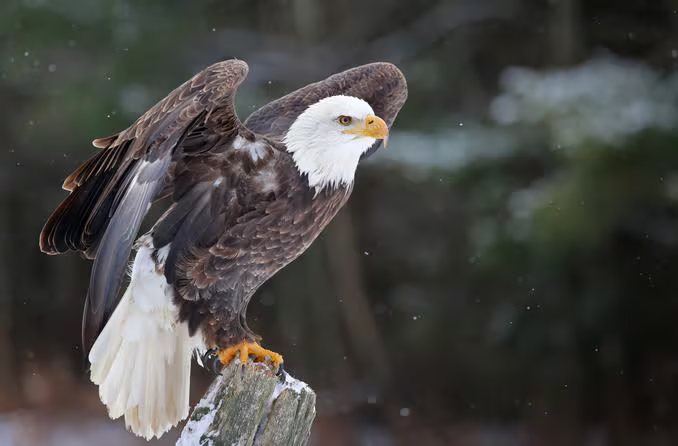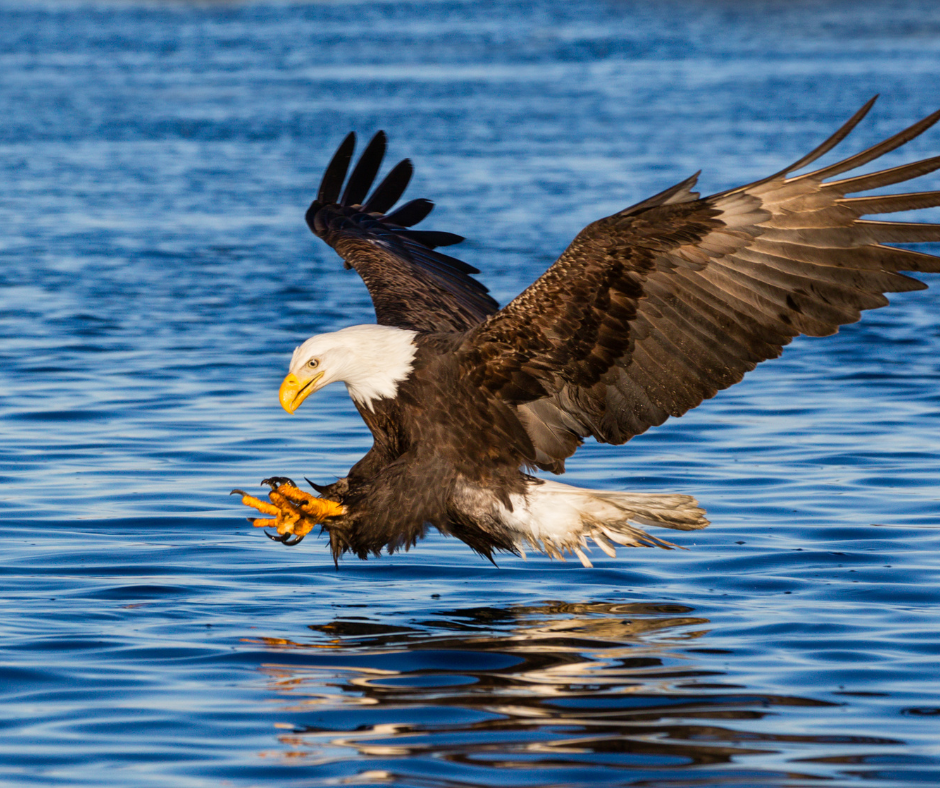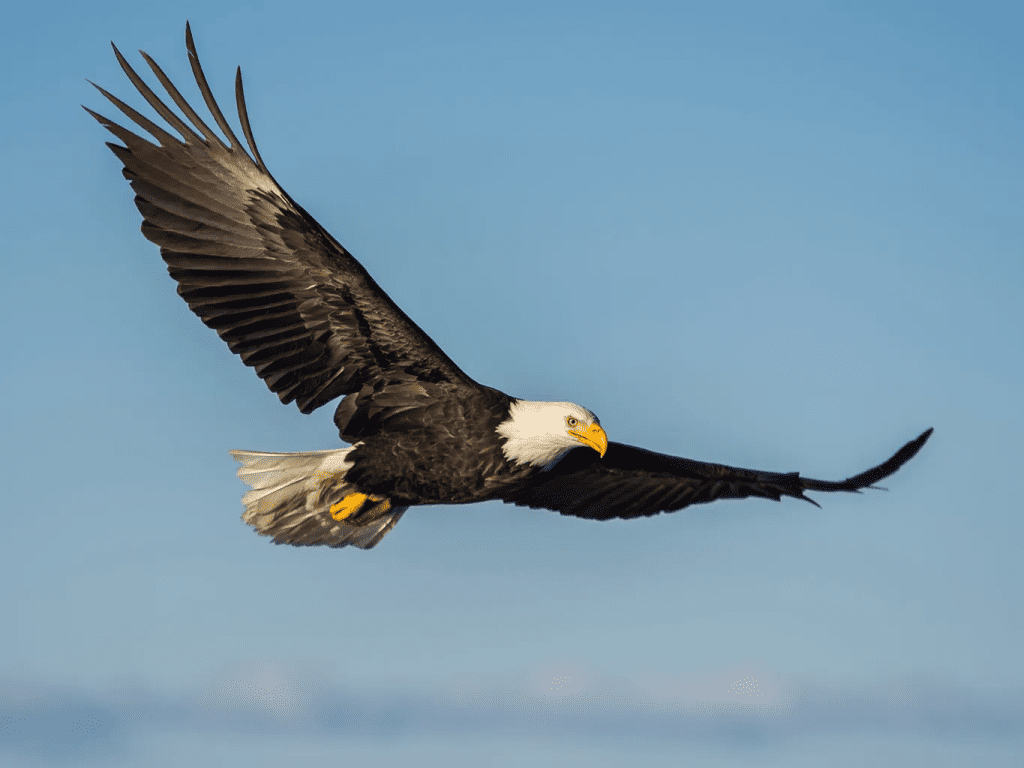Ever wondered how an eagle can swoop down from the sky and snatch a fish right out of the water with flawless precision? It’s not just skill — it’s next-level eyesight. Eagles are like flying cameras, equipped with ultra-high-definition vision that puts modern drone tech to shame.
These majestic birds don’t just glide through the air — they hunt with purpose. Their eyes are designed for the skies, and when you learn just how powerful their vision really is, it’s hard not to be amazed.
Eagle Vision: Better Than 20/20

Most humans consider 20/20 vision to be perfect. But eagles? They blow that out of the water.
Eagles are believed to have 20/5 vision, meaning they can see from 20 feet away what a human would only see clearly at 5 feet. That’s four times sharper than our best natural vision. This insane clarity allows them to pick up details we’d miss entirely — like a small fish flicking near the surface of a river, all from hundreds of feet in the air.
Imagine being able to spot a coin on the ground while standing on top of a 10-story building — that’s the eagle’s world.
Glare? Not a Problem for Eagles
Now, let’s talk about water. Even on a sunny day, the surface of a lake or river can be like a mirror — filled with glare and reflection. For us, it’s tough to see past it. But for eagles?
Their eyes are naturally equipped to filter out glare. They have a special structure in their retina that reduces the interference caused by reflected light, allowing them to cut through brightness and focus on movement beneath the surface. It’s like wearing polarized sunglasses — except built-in, and way more advanced.
Video : The Incredible Eyesight of Eagles: Nature’s Sharpest Vision
So while we might squint at a shiny lake, an eagle is already locked on to lunch.
Binocular Vision That Tracks Targets Mid-Air
You’ve probably heard the term “binocular vision” before — it’s what allows animals (and humans) to judge distance. Eagles have this too, but with a supercharged twist.
Their eyes face slightly forward, giving them excellent depth perception. And because they can move their heads smoothly while keeping their eyes locked on a target, they maintain laser focus even during high-speed dives. That means they can:
- Track a moving fish
- Calculate the angle of attack
- Time their dive to the millisecond
No second guesses. No hesitation. Just pure precision.
A Wide-Angle Field of View Without Losing Detail
Another wild fact? Eagles have a field of view of about 340 degrees — nearly a full circle. Yet somehow, they manage to maintain pinpoint detail in their central vision.
Their retinas are loaded with cone cells, which detect fine details and colors. This gives them a massive advantage: they can scan a huge area while simultaneously zooming in on one moving object. It’s like having both a panoramic lens and a telephoto lens active at the same time.
While you’re blinking at a blurry bird in the sky, the eagle already sees you — and probably knows what brand of hat you’re wearing.
How Eagles Use Vision to Hunt

Let’s break it down. Picture an eagle flying 300 feet above a river. It’s calm, quiet, and the water’s shimmering. Then, with almost no warning, the eagle changes course. Its wings pull in tight, and it drops like a missile.
Why? Because its eyes just caught a tiny flash beneath the surface — a fish swimming near the top.
The eagle:
- Adjusts its position mid-flight
- Times its dive perfectly
- Uses its talons to grab the fish — often without getting fully wet
This all happens in seconds. And it all begins with a flash of movement that you and I wouldn’t even notice.
Evolution Built the Ultimate Predator’s Eye
Eagles didn’t just wake up one day with superhero vision. This visual power is the result of millions of years of evolution, fine-tuned for survival.
Their eyesight helps them:
- Hunt more efficiently
- Avoid threats
- Navigate wide territories with ease

In the wild, vision is survival, and eagles have mastered that art. From open skies to dense forests, they rely on their vision more than anything else. It’s their secret weapon — and honestly, their superpower.
How Eagles Compare to Human Technology
Think your 4K drone is impressive? Eagles would laugh — if they could.
While drones rely on lenses and software to zoom and focus, eagles do it naturally and in real-time. No battery required. No GPS lag. Just pure instinct and biological design.
Their eyes offer:
- Superior motion detection
- Real-time tracking
- Optical clarity beyond anything man-made
In fact, researchers studying eagle vision have helped inspire improvements in camera lenses, tracking systems, and even augmented reality.
Why It All Matters: Nature’s Design Is Still Unmatched
Eagles remind us of something powerful — nature still does it better. We’ve created incredible tools and gadgets, but the eagle’s eye shows that evolution’s been doing high-tech for much longer.
Video : Just How Good is Eagle Vision?
Next time you see one soaring in the sky, take a moment. You’re looking at a living, breathing marvel — one that can see better, move faster, and hunt smarter than any drone or AI-powered camera.
Conclusion: Eyes on the Skies
Eagles aren’t just symbols of power — they’re visual masters of the natural world. With vision four times sharper than ours, built-in glare filters, and targeting precision that feels almost mechanical, they dominate the skies like no other.
Their eyes are their greatest weapon — and their greatest gift.
So, the next time you see an eagle circling high above, remember: it sees you… in more detail than you’ll ever see it. And that’s not magic — that’s evolution in high definition.
Think your eyes are sharp? Nature’s got you beat — try spotting a fish from 300 feet up.
4 times Taylor Swift went makeup-free and looked flawless

Swifties, her devoted fan group, are well-known for her gorgeous makeup appearances in addition to her musical prowess and amorous exploits. Ever before her breakout single “Tim McGraw” reached the top of the Billboard charts in 2006, the singer has dabbled in a range of cosmetic appearances. In addition to lengthy lashes, Swift has also dabbled in pink tones, blue eyeliner, dark, smokey eyes, and cat eyes that are “sharp enough to kill a man.” Not to mention how flawlessly she’s worn every red lipstick. Have you ever pondered, though, how Taylor Swift looked by herself?
The star has openly admitted to have the reasonable but unwanted tendency of forgetting to remove her makeup, despite her appearing flawless beauty. In 2011, Swift told Allure, “I don’t always remember to remove my makeup. Alright, pretty much all the time.” The pop queen, though, appears just as stunning without makeup as she does when taking the stage at her sold-out gigs and appearing on TV.
paired with a grin

On January 22, 2019, Taylor Swift shared a carefree selfie wearing a denim jacket, lovely dirty blonde hair brushed to the side, and minimal makeup. She put a smile next to her “Cats” character, Bombalurina, with the proper hashtag, “Meow,” in the caption of the picture. Even without makeup, the celebrity had gorgeous eyes, full lips, and clear skin. With raised eyebrows and a slightly menacing appearance, this selfie radiates a dynamic feeling, which is enhanced by the absence of cosmetics.
Still, what can we say? You really are lovely.
On October 24, 2022, Taylor Swift demonstrated that makeup is not required to take a depressing photo, especially when she was announcing the release of her most current album. The musician, dressed in fairytale-inspired clothing, looked stunning without makeup, gazing off into the distance with her hair styled in a braided bun. The ad image’s description went on, “Midnight, such a famous and storied hour… This sparkling evening, I’ll be offering my personal interpretation of a well-known fable. Given the success of her “Midnights” album, this picture not only demonstrated Swift’s natural beauty but also her inner and outer brilliance.

True Swifties all know that Taylor Swift loves to look nice in sweaters, or should we say, cardigans. On October 24, 2018, the artist disclosed her love for turtlenecks—possibly more than her taste in makeup. The music diva flaunted her famous blond bangs and gorgeous blue eyes in a photo she took while sporting a black, form-fitting turtleneck. The post’s description joked, “Here we can observe an Australian swiftlet in her natural habitat, a turtleneck.” The subsequent images in the post showcase Swift experimenting in a natural Australian location, contributing to the grounded and organic vibe of the selfie.
Never go out of style

During the COVID-19 lockdowns, almost all active social media users posted at least one picture of themselves taken at home without makeup and captioned it with something about how bored they were. Following the trend, Taylor Swift shared a stunning makeup-free selfie on Instagram on April 27, 2020. She added, “Not a lot going on at the moment,” as the caption for the photo, her characteristic blond curls hanging just over her clavicle as she looked straight into the camera. Swift’s caption discussed the lockdown experience, but what really caught viewers off guard—or not—was how beautifully makeup-free Swift appeared.



Leave a Reply